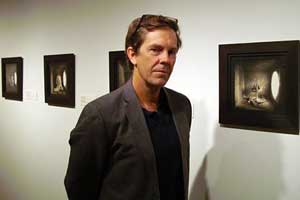An Eye for Food
Photographer David Halliday’s exhibit of food photos is on display at the San Antonio Museum of Art
by Liz Pearson, ZESTER DAILY

David Halliday
Nineteen years ago, David Halliday moved to New Orleans to be a chef in a food-obsessed city; now he’s a photographer. As it turns out, his path between the kitchen and the dark room is deliciously short.
We talked to Halliday”s about his current exhibit, “Culinary Delights: Photographs by David Halliday,” which is on view at the San Antonio Museum of Art through Feb. 21.
How did you first start cooking in restaurants?
After making a couple of wrong turns — I switched from art school to photojournalism, for instance — I left college in 1980 and moved to New York. I didn’t want to do commercial work in photography, so I took a job in a restaurant.
What brought you back to photography?
In New York, I devoted myself to cooking. Then in 1991, a friend asked me to come down to New Orleans to cook with him here. Eventually, it was just too exhausting and I wanted to start taking pictures again. Over the next 10 years it was a combination of making and exhibiting photos and cooking more for a paycheck than as an aesthetic endeavor. But by then I had this understanding of food.
You photograph subjects other than food too, so what was the genesis of this current food-themed exhibit?
It was sort of a San Antonio moment; it was all [curator] David Rubin’s doing. The Culinary Institute of America recently opened a campus here, and there are new farmers markets popping up. I think David wanted to do something for the museum that specifically related to that community.
What does the exhibit”s title, “Culinary Delights,” mean to you?
I can’t help getting “Hieronymus Bosch” about it; it reminds me of [the painting] “The Garden of Earthly Delights.” Maybe David Rubin is twisting that idea in some softer way. I think there”s something funny about that.
The exhibit’s most compelling photos are the Box Series, where you’ve photographed familiar ingredients inside a tin box using natural light. Because the food is so personified, the effect is that of a dressing room, close-up and voyeuristic.
I agree with you! Those photos were actually taken over a series of three trips to Italy (2000, 2002 and 2004). I arranged the food in an old, glass-topped tin biscotti box that I found in an abandoned building there. It had a round, elliptical window, and to me, it became a room. The physical qualities of the ingredients are so alluring that that’s all you see. That you”re actually looking at a photograph almost becomes secondary.
How did you pick which foods to photograph in the tin box?
I chose items that typified Italian produce and ingredients. Artichokes, octopus, cherries …
That series, along with other photos of yours that feel a bit like 17th- and 18th-century still lifes, seem uniquely Italian.
Yes, I was exposed to that at the time. Actually, while I was doing the Box Series, I also made a photograph titled “Uva/Uova (Grapes, Eggs), 1998.” Back then, that Caravaggio still life with grapes was on the lire notes everywhere, and I took that photo in a very Caravaggio way. But I particularly like the “Box Series” because I think it’s stylistically its own.

Octopus, 2000
What do you make of the ingredients to photograph back home in New Orleans?
I’m kind of a forager around town. Thankfully, the markets are getting better. They’ve gone from slicing and dicing your vegetables for you to pulling them out of the earth and going straight to market. Really, I have very simplistic tastes about what to eat here. I think small, and look for ingredients prepared by someone who treats them like they’re something you just can’t live without.
Are you fond of any uniquely southern ingredients?
I’ve shot mirlitons, and the bananas here are primordial and exotic; they captivate my attention. I cook collard greens all of the time, but I haven’t figured out how to photograph them yet. Some of the seafood here, which I love — shrimp, oysters, crawfish — I think is a deserving subject for the camera, and for the stomach, of course.
You originally came here to cook, so do you ever think about leaving New Orleans?
For me, New Orleans provides a patina and character. Sometimes I think I’d love to pack it up and get out of here, but I might end up losing that element of my work. Photos like “Banana (Diptych), 1995” are about New Orleans ingredients as marvelous creatures. They’re sort of my own wide-eyed “wow” for the food here.
Is there any ritual involved in cooking and eating your subjects after you’re done photographing them?
The fish in “Five Fish, 2007” I cooked and ate those. And I loved the fish heads; the same ones appear again in “Fish Heads and Pumpkins, 2007.” They were resting in a pile on the paper from the market and they looked unbelievable. Afterwards, I pan-fried the fish with some olive oil and a squeeze of lemon juice, and that was it. In “Cauliflower (Cavalfiore), 2000”, the cauliflower itself made that photograph. It personified the unique architecture of vegetables. I’m sure I ate that.
Does photography give you the same connection to food that cooking used to?
There’s a lot of pleasure in being attentive to the same ingredients that I used to cook with. Now, I want to cultivate the things I photograph. My greatest desire is to grow the food. I have some broccoli coming up in the back yard that I”m eyeing. I’m thinking, hmmm … Am I going to eat these or photograph these? No reason not to do both.
